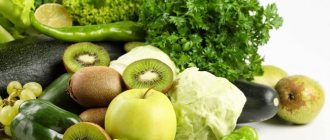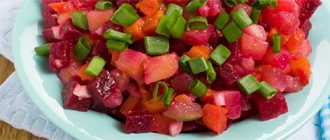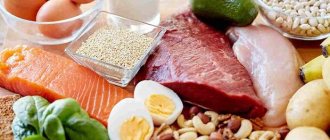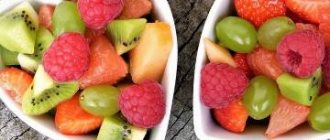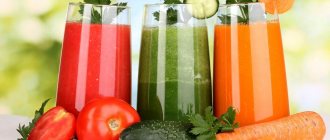Color diet. WEDNESDAY
Green foods include peas, white cabbage, salads, spinach, celery, peppers, cucumbers, apples, kiwi, grapes, lentils, avocados, tea, parsley, dill, zucchini and others. Juices and herbal teas with the addition of lime are suitable for drinking. Green shades have a positive effect on the psycho-emotional and physical state of a person.
They give a feeling of confidence, calm, balance, harmony. Relieves stress and tension. And peace inside gives external attractiveness. Chlorophyll is beneficial for human health. It reduces muscle tone, cholesterol levels, protects against viruses and dangerous bacteria.
A “ green” diet is used to treat arrhythmia, glaucoma, fatigue, excess weight, headaches, and general fatigue.
color diet for other days here >>>
Cucumber
Among green vegetables, the most popular is the juicy, refreshing cucumber. This is an invariable component of summer salads and a wonderful light snack. Vegetables provide the body with the following benefits:
- Fights dehydration. A cucumber is 95% water. The fruit helps replenish the lack of life-giving moisture, which has a positive effect on the functioning of internal organs and the condition of connective tissue.
- Eliminates swelling. This can be achieved thanks to its mild diuretic effect.
- Prevents obesity. Tatronic acids prevent the transformation of carbohydrates into adipose tissue.
- Prevents the formation of kidney stones. Salts restore the acid-base balance, removing all excess from the bladder and kidneys.
- Heals the thyroid gland. This function is provided by the increased iodine content.
The watery texture of the cucumber is both an advantage and a danger of the vegetable. The fruit is prone to the accumulation of harmful substances from the soil and environment. Therefore, you need to eat only cucumbers from your own garden or purchased from trusted summer residents.
Relevant products in the Online store:
John Frieda
Violet Crush Shampoo with violet pigment to neutralize yellow tones in blonde hair
from 758 rub.
best-seller
Kérastase
NUTRITIVE Light nourishing milk for smoothness and softness of normal hair
from 3,168 rub.
Kérastase
NUTRITIVE Intensely nourishing mask for dry and very dry hair
from 3,510 rub.
John Frieda
Violet Crush Conditioner with violet pigment to restore and maintain the shade of blonde hair
from 758 rub.
best-seller
All goods
Sample menu
A sample menu for the week will guide you in organizing your diet and choosing dishes for each meal. Serving sizes are not provided as individual serving sizes will vary. After all, to lose weight, some will have to reduce their daily caloric intake to 1,500 kcal, and some - to 1,800. Based on this, you need to measure the amount of food.

If the diet is designed for no more than 7 days, you don’t need to change anything in the menu. If it lasts longer, you can increase the amount of protein and sometimes replace some dishes with your favorite ones. For example, a couple of times a week you can drink not green, but black coffee in the morning. Or make an orange smoothie instead of a spinach smoothie. The main thing is not to give up and finish the job you started.
Options
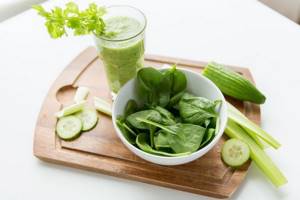
You can take any product from the above list and arrange a mono-diet on it for 3-5 days (no more). What are the options:
- cucumber mono-diet;
- cabbage;
- pea;
- grape;
- apple;
- on kiwi;
- on avocado;
- on “live” buckwheat;
- on kelp.
However, nutritionists insist that much more benefits for both figure and health will come from a diet that includes different foods. Moreover, it can also be presented in several versions:
- fruity;
- vegetable;
- fruit and vegetable;
- fruit and berry;
- on greenery;
- on fat-burning smoothies;
- mixed.
And again, the last option is considered the most useful and most acceptable.
On a note. If you have the opportunity, be sure to try the coral cabbage (Romanesca). You might be surprised that this vegetable could be the food of the gods! The texture is delicate, the taste is soft, creamy and nutty, without any bitterness.
Types and their composition
The list of varieties of green vegetables can be divided into fruits and green leafy crops. It is important to know which of them should be frequent guests on our table and why.
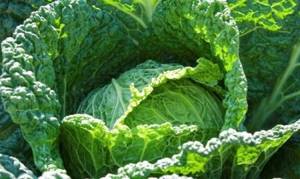
- Miniature heads of Brussels sprouts provide health benefits due to the content of B vitamins, as well as A, E, K, C, dietary fiber, organic acids and minerals.
- Kohlrabi is another member of the cabbage family. This vegetable comes in burgundy and light green colors. The juicy greenish fruit has the taste of a sweet stalk. Strengthens the nervous system and blood vessels; due to the abundance of vitamin C, it is also called the “northern lemon”.
- Cucumber. Its health benefits are undeniable. This oblong vegetable contains enough potassium for normal heart function, folic acid, zinc, iron, fiber and many vitamins. It is especially useful to include cucumbers in the diet of people who are losing weight due to the large amount of water they contain and low calorie content.
- Asparagus. Its long shoots contain all the important vitamins and very useful microelements necessary for men's health. A substance from asparagus (the second name for asparagus) - aspargine, increases vascular permeability, which means it is useful for people suffering from thrombosis and high blood pressure.
- Green pea. This representative of the legume family deserves attention due to its beta-carotene, vegetable protein, abundance of folic acid, lutein and B vitamins in its composition. Indispensable for people who are often exposed to stress and athletes for muscle growth.

- Celery stalks. The juicy and spicy relative of parsley is endowed with elements that improve metabolism, lower cholesterol, stimulate brain activity, and provide energy. Celery, like cabbage, is a negative calorie vegetable - that is, the body spends more calories digesting it than it contains.
- Green onions. Speaking of stems, let's talk about green onions, the feathers of which are the first to break through the garden in the spring, giving us a big vitamin boost after a long winter. Many varieties of onions are used for greens - chives, leeks, batun, slime, shallots and others. Onion feathers have a more delicate taste than the onion itself; they also contain many useful elements. Green onions contain choline, carotenoids, ascorbic acid, vitamin K, E, A, sodium and rare selenium.
- Green bell pepper. Another winner in terms of vitamin C content, two fruits of which are enough to consume to obtain the daily requirement of this important antioxidant vitamin, which strengthens the immune system. Contains essential oils that add aroma to the fruit, a lot of potassium, good for the heart, iron, sodium, magnesium.
- Avocado is an overseas fruit of the laurel family. Some consider it a fruit, others a vegetable, but the benefits of this oily fruit with a seed inside are undeniable. Vegetable fats, polyunsaturated fatty acids, which maintain the elasticity of our blood vessels, a lot of vitamin A, potassium, magnesium and iron are indispensable for the proper functioning of the heart muscle and blood vessels.
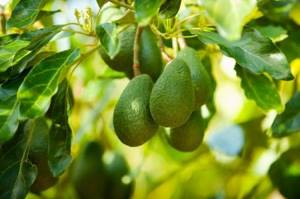
- Zucchini, zucchini. Green fruits from the pumpkin family have low calorie content (23 kcal per 100 g), contain fiber, manganese, calcium, phosphorus, potassium, vitamins B, C. They activate the intestines without irritating them, are useful for frequent stress, high blood pressure, obesity, as a prevention of atherosclerosis. Young zucchini or fresh zucchini are made into thin shavings that are eaten raw.
A large proportion of green vegetables are leafy crops. Health benefits are provided not only by little-known overseas species, but even by simple tops from some root vegetables. Let's take a closer look at their beneficial composition.
Celery
Celery is an unusual green vegetable. The photo presents it to us in the form of a dense, juicy stem attached to a massive tuber. It is the petioles that are of greatest interest. This applies to both the unusual spicy taste and a wide range of beneficial properties:
- increases physical endurance;
- fights constipation;
- speeds up metabolism;
- eliminates congestion in the body;
- strengthens the body's protective barriers;
- inhibits the aging process;
- accelerates the restoration of damaged tissues;
- increases sexual activity;
- removes sand from the kidneys;
- enhances brain activity.
Among the key contraindications to consuming celery are hypotension, pregnancy and breastfeeding. People suffering from gastritis should also avoid this product.
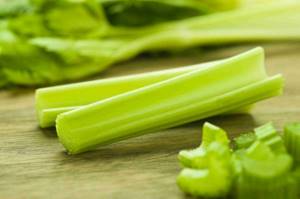
Related materials:
color | white | red | orange | yellow | green | purple | brown | Diet | products | slimness | calories | Vitamins | organism | diet | Nutrition
Articles
- Macrobiotic nutrition: religion or diet July 7, 2013, 00:00
- Diet menu: 8 light varieties of cheese January 29, 2014, 00:00
- They meet you by their clothes: Psychology of color September 04, 2021, 00:00
Video
- Makeup for Halloween from MAKE UP FOR EVER. White Angel October 28, 2010, 00:00
- Fall colors from Clinique October 11, 2011, 09:26
- Makeup for the red carpet from Max Factor April 21, 2014, 17:00
Nutritional value of green leafy vegetables
Leafy greens are the best source of healthy nutrients. Through various studies, scientists have concluded that a daily bowl of green vegetable salad can provide the following nutrients:
- calcium 9%;
- cholesterol 0 mg;
- dietary fiber 2.2 g;
- iron 15%;
- magnesium 19%;
- potassium 55 mg;
- protein 2.9 g;
- sugar 0.4 g;
- vitamin A 87%;
- Vitamin B 10%;
- Vitamin C 46%.
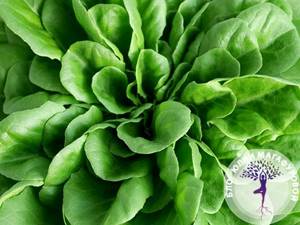
Green pea
The list of green vegetables should be continued with sweet and aromatic green peas, which are loved by both adults and children. The vegetable was first grown in India more than 5,000 years ago, and today it is loved all over the world. And not only for its gastronomic properties, but also for its exceptional benefits, which are expressed in the following:
- Peas are high in folic acid, vitamins K and B6, as well as lutein. This “cocktail” keeps the heart muscle toned and strengthens the walls of blood vessels.
- Fiber has the ability to regulate metabolic rate. The substance promotes the removal of toxins and improves intestinal motility.
- Peas contain a lot of manganese, as well as half the daily value of vitamin K. This combination helps strengthen bones and prevents calcium loss.
- The plant pigment lutein in combination with vitamin A prevents a decrease in visual acuity. Regular consumption of peas protects the retina from damage.
Unfortunately, not everyone is recommended to indulge in sweet green peas. It contains substances that can worsen gout symptoms. People suffering from kidney stones should also avoid this vegetable.
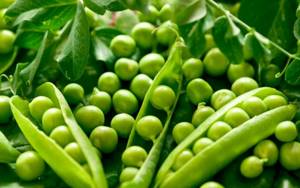
Green pepper
Peppers are another super-healthy green vegetable. The species is widespread in Mediterranean countries. Unfortunately, this product does not appear on domestic tables very often. However, if you want to always feel good, be sure to eat green peppers, because they have the following beneficial properties:
- stimulates digestion processes;
- supports normal pancreas function;
- stimulates appetite;
- normalizes blood pressure;
- thins the blood;
- strengthens hair, teeth and nails;
- normalizes blood sugar levels;
- strengthens the immune system.
People suffering from ischemia and angina pectoris should avoid eating green pepper. It is also not recommended for nervous disorders.

Additional recommendations
It is better to organize a diet in the summer, when there is no shortage of fresh plant foods. In winter, deprived of sunlight or frozen and thawed several times, they no longer contain many useful substances.
The greatest benefit will come from those products that are grown on your own plot. When you pick greens from the garden, you can be sure of their freshness and environmental friendliness. If you don’t have your own land, it’s better to buy from farmers. Greenhouse plants can be grown with chemicals that are harmful and even toxic to the body. Store-bought ones most often sit on shelves for several days and cannot claim freshness.
Spoiled, unripe, unripe, moldy, rotten foods cause serious stomach upsets (diarrhea, cramps). Therefore, they must be removed immediately.
A mandatory step is thorough rinsing under cold running water. After this, the greens are shaken thoroughly, laid out on a paper towel, and left in the air for 15-20 minutes. Vegetables, fruits and berries are thoroughly wiped. Leaving water on them speeds up the rotting process.
During heat treatment, chlorophyll is destroyed. Therefore, to get the most out of green foods, it is best to eat them raw. However, it is not recommended to stay on such a diet for a long time. The best option is 3-5 days. Then indigestion may begin.
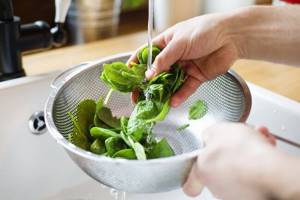
To preserve the beneficial properties of green foods when cooking, you need to follow several rules:
- Boil in plenty of lightly salted water.
- It should boil vigorously before lowering.
- Cooking time - no more than 10 minutes. For cabbage - 5 (until al dente).
- Immediately after cooking, take a cold shower under running water. Alternatively, take a bath with ice cubes (leave in the water for 15 minutes).
Green vegetables will not lose their beneficial properties if you steam them.
Recommended dishes:
- salads;
- soups;
- smoothies, cocktails, juices.
Don’t forget also about green buckwheat and pasta (they most often contain dry concentrate of spinach or any other greens), which will become an excellent side dish during the diet.
Lifehack. For those who are actively involved in sports, the Liquid Chlorophyll dietary supplement from Now Foods will be an excellent help during a green diet. This is liquid chlorophyll with mint flavor. The manufacturer focused on the property of this unique substance to accelerate nitrogen metabolism in tissues, thereby promoting muscle growth.
Asparagus
In the list of green vegetables, asparagus is one of the most valuable representatives. But, unfortunately, it has not yet taken its rightful place in the domestic gastronomic consciousness. But in vain, because it brings invaluable benefits to the body:
- normalization of blood pressure;
- combating skin problems;
- blood thinning;
- elimination of arrhythmia;
- reducing the risk of heart attack;
- strengthening the walls of blood vessels;
- slowing down the aging process of the body;
- normalization of blood sugar;
- kidney cleansing;
- fight against edema;
- improved digestion;
- improved vision;
- normalization of sleep;
- fighting depression;
- anemia treatment.
If you are interested in asparagus, please note that its use has contraindications. In particular, it should not be used by people suffering from prostatitis and cystitis, as urination will become more frequent and the symptoms will worsen. Caution should also be exercised by those who suffer from diabetes and rheumatism.
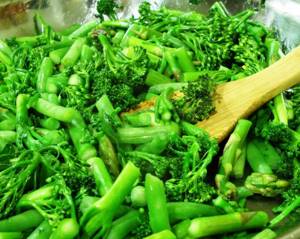
Sample daily menu on a green diet
Perhaps there are weight loss fanatics who, having believed in the significant benefits of a green diet, will completely and dramatically change their diet, trying to make their breakfasts, lunches and dinners entirely from green products. Don't go to extremes!
The body's needs for protein and a minimum amount of fat (without which, by the way, many vegetables simply cannot be digested and become useless) have not yet been canceled. This means that you need to try, while maintaining common sense, to create your daily menu from products that are not only green and low-calorie, but also healthy in the generally accepted sense. For example:
- Breakfast: 100 g low-fat cottage cheese, 1 glass low-fat kefir; 2 green apples, green tea;
- Second breakfast: a handful of pine nuts, 1 tbsp. bran;
- Lunch: any light soup (for example, fish, turkey or vegetable), fresh cabbage and cucumber salad (you can add 1 tsp olive oil and a little soy sauce); after an hour - any fruit;
- Dinner: any meat or fish, steamed or grilled; salad of leafy vegetables with 50 g of feta cheese (seasoned with 1 tsp olive oil);
- An hour before bed: 2 egg whites.
What products are prohibited?
Prohibited items include:
- fatty meat and animal fats (including butter), canned and smoked foods, semi-finished products;
- potatoes, corn, beans (except green beans), peas, rice, starch;
- wheat bread, pastries, desserts, sugar;
- pizza, dumplings, dumplings;
- mayonnaise, sauces;
- persimmons, dates, mangoes, grapes (except green varieties), bananas, apricots, other fruits, except those allowed, dried fruits;
- carbonated and alcoholic drinks.


